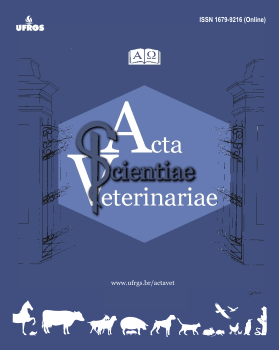Uterine Torsion Associated with Open Pyometra in a Bitch
DOI:
https://doi.org/10.22456/1679-9216.107276Abstract
Background: Pyometra or pyometritis is a serious and common condition of intact female dogs characterized by the inflammation of the uterus with a buildup of purulent exudate. It may be classified as open or closed. If untreated, pyometra can lead to uterine rupture and sepsis. Pyometra may also predispose to uterine torsion, defined as a rotation of one or both uterine horns around its longitudinal axis. Uterine torsion in female dogs is rare, and usually with late pregnancy or parturition. This case report describes the clinical presentation and therapeutic management of uterine torsion correlated with open pyometra in a non-gravid bitch with no history of exogenous progesterone exposure.
Case: A 10-year-old intact Yorkshire Terrier bitch weighing 3.2 kg was referred to a veterinary clinic in Porto Alegre, Brazil, with a 7 day history of prostration, anorexia, polydipsia, and sanguinopurulent vulvar discharge. Physical examination revealed pronounced abdominal tenderness. On abdominal ultrasonography, the uterus was enlarged and filled with cellular anechoic content, suggestive of pyometra. A complete blood count showed mild microcytic normochromic anemia and leukocytosis. The animal was stabilized and an urgent ovariohysterectomy was performed. Preanesthetic analgesia consisted of subcutaneous methadone 0.3 mg/kg. Anesthesia was induced with propofol 3 mg/kg i.v. and maintained with inhaled isoflurane. During the procedure, significant enlargement of the left uterine horn and slight enlargement of the right uterine horn were observed. In addition, a torsion was identified near the left ovary, with copious sanguinopurulent secretion. The animal remained under observation and fluid therapy for 48 h after the procedure and was discharged to postoperative follow-up. After discharge, the following treatment was medicine, local cleaning and rest for 14 days. Concluding the therapeutic process with a satisfactory outcome.
Discussion: Uterine torsion is considered rare in female dogs, and when it does occur, it is usually associated with late pregnancy or parturition. In this case, pregnancy was not a predisposing factor, but the animal had pyometra, which may have contributed to the torsion. Exogenous progesterone administration to inhibit the estrous cycle significantly increases the risk of pyometra; however, in the case reported herein, there was no history of progesterone therapy. The most likely cause was prolonged, repeated progesterone stimulation in the luteal phase, since the animal developed pyometra at the age of 10. Both uterine torsion and pyometra may progress to cause severe systemic complications. However, none was observed in the present case. Despite the high mortality rate, the animal survived, probably due to the open pyometra, which is associated with better prognosis than closed pyometra. Nevertheless, drainage was not enough to relieve enlargement of the uterus and ligaments, which may have facilitated torsion. Pyometritis associated with uterine torsion has rarely been reported in the literature, especially in small animals. Early diagnosis is key, as is surgical treatment via ovariohysterectomy. The surgical procedure had therapeutic purpose and was managed satisfactorily. The mechanism of uterine torsion has yet to be fully elucidated, which highlights the importance of this report. Additionally, it is rare in dogs, with very few reports in the non-gravid uterus.
Downloads
References
Barrand K.R. 2009. Unilateral uterine torsion associated with haematometra and cystic endometrial hyperplasia in a bitch. Veterinary Record. 164: 19-20. DOI 10.1136/164.1.19.
Carvalho V.H.A., Dominici P.H., Silva K.K. & Silva E.G. 2014. Torção unilateral de útero não gravídico em uma cadela - relato de caso. In: 35º Congresso Brasileiro da Associação Nacional de Clínicos Veterinários de Pequenos Animais - ANCLIVEPA (Belo Horizonte, Brasil). pp.112-114.
Chambers B., Laksito M., Long F. & Yates G. 2011. Unilateral uterine torsion secondary to an inflammatory endometrial polyp in the bitch. Australian Veterinary Journal. 89(10): 380-384. DOI: 10.1111/j.1751-0813.2011.00820.x
Coggan J.A., Oliveira C.M, Faustino M., Moreno A.M., Von Sydow A.C., Melville P.A. & Benites N.R. 2004. Microbiological study of intrauterine secretion from bitches with pyometra and research of virulence factors of Escherichia coli isolates. Arquivos do Instituto Biológico. 71: 1-749.
Hagman R., Karlstam E., Persson S. & Kindahl H. 2009. Plasma PGF 2α metabolite levels in cats with uterine disease. Theriogenology. 72(9): 1180-1187.
Misumi K., Fujiki M., Miura N. & Sakamoto H. 2000. Uterine horn torsion in two non‐gravid bitches. Journal of Small Animal Practice. 41: 468-471. DOI:10.1111/j.1748-5827.2000.tb03144.x
Patil A.R., Swamy M., Chandra A. & Jawre S. 2013. Clinico-haematological and serum biochemical alterations in pyometra affected bitches. African Journal of Biotechnology. 12(13): 1564-1570.
Silveira C.P.B., Machado E.A.A., Silva W.M., Marinho T.C.M.S., Ferreira A.R.A., Burger C.P. & Costa Neto J.M. 2013. Estudo retrospectivo de ovário-salpingo-histerectomia em cadelas e gatas atendidas em Hospital Veterinário Escola no período de um ano. Arquivo Brasileiro de Medicina Veterinária e Zootecnia. 65(2): 335-340.
Trautwein L.G.C., Sant'Anna M.C., Justino R.C., Giordano L.G.P., Flaiban K.K.M.C & Martins M.I.M. 2017. Piometras em cadelas: relação entre o prognóstico clínico e o diagnóstico laboratorial. Ciência Animal Brasileira. 18: 1-10. DOI 10.1590/1809-6891v18e-44302
Volpato R., Martin I., Ramos R.S., Tsunemi M.H., Laufer-amorin R. & Lopes M.D. 2012. Imunoistoquímica de útero e cérvice de cadelas com diagnóstico de piometra. Arquivo Brasileiro de Medicina Veterinária e Zootecnia. 64(5): 1109-1117.
Published
How to Cite
Issue
Section
License
This journal provides open access to all of its content on the principle that making research freely available to the public supports a greater global exchange of knowledge. Such access is associated with increased readership and increased citation of an author's work. For more information on this approach, see the Public Knowledge Project and Directory of Open Access Journals.
We define open access journals as journals that use a funding model that does not charge readers or their institutions for access. From the BOAI definition of "open access" we take the right of users to "read, download, copy, distribute, print, search, or link to the full texts of these articles" as mandatory for a journal to be included in the directory.
La Red y Portal Iberoamericano de Revistas Científicas de Veterinaria de Libre Acceso reúne a las principales publicaciones científicas editadas en España, Portugal, Latino América y otros países del ámbito latino





